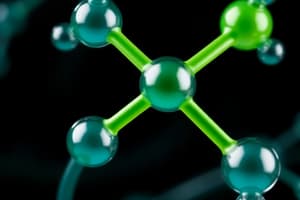Podcast
Questions and Answers
What dictates a molecule's properties and reactivity?
What dictates a molecule's properties and reactivity?
- Molecular Weight
- Atomic Mass
- Chemical Bonds
- Functional Groups (correct)
Which law states that mass is neither created nor destroyed in a chemical reaction?
Which law states that mass is neither created nor destroyed in a chemical reaction?
- Ideal Gas Law
- Charles's Law
- Avogadro’s Law
- Law of Conservation of Mass (correct)
What does the Ideal Gas Law express with the equation PV = nRT?
What does the Ideal Gas Law express with the equation PV = nRT?
- The relationship between volume and concentration
- The relationship between pressure, volume, number of moles, and temperature (correct)
- The relationship between pressure and temperature only
- The relationship between volume and molecular weight
Which laboratory technique is used to determine the concentration of a substance in a solution?
Which laboratory technique is used to determine the concentration of a substance in a solution?
Which analytical technique measures the interaction of light with matter?
Which analytical technique measures the interaction of light with matter?
What defines a compound?
What defines a compound?
Which type of bond occurs when electrons are shared between two atoms?
Which type of bond occurs when electrons are shared between two atoms?
In which state of matter do particles move freely and are far apart?
In which state of matter do particles move freely and are far apart?
What occurs during a synthesis reaction?
What occurs during a synthesis reaction?
Which pH value indicates a neutral solution?
Which pH value indicates a neutral solution?
Flashcards are hidden until you start studying
Study Notes
Basic Concepts of Chemistry
- Matter: Anything that has mass and occupies space.
- Atoms: The fundamental building blocks of matter, composed of protons, neutrons, and electrons.
- Elements: Pure substances made of only one type of atom (e.g., Hydrogen, Oxygen).
- Compounds: Substances formed from two or more different types of atoms bonded together (e.g., Water - H₂O).
Chemical Bonds
- Ionic Bonds: Formed when electrons are transferred from one atom to another, leading to the formation of charged ions.
- Covalent Bonds: Formed when two atoms share one or more pairs of electrons.
- Metallic Bonds: Formed between metal atoms, where electrons are shared in a 'sea of electrons' allowing for conductivity.
States of Matter
- Solid: Definite shape and volume, particles closely packed.
- Liquid: Definite volume but takes the shape of its container, particles are less tightly packed than solids.
- Gas: No definite shape or volume, particles are far apart and move freely.
Chemical Reactions
- Reactants: Substances that undergo the change in a chemical reaction.
- Products: New substances formed as a result of a chemical reaction.
- Types of Reactions:
- Synthesis: Two or more reactants combine to form a single product.
- Decomposition: A single compound breaks down into two or more products.
- Single Replacement: One element replaces another in a compound.
- Double Replacement: Exchange of ions between two compounds.
The Periodic Table
- Groups: Columns that indicate similar chemical properties (e.g., Group 1 - Alkali Metals).
- Periods: Rows that show the increasing atomic number of elements.
- Metals, Nonmetals, and Metalloids: Classification based on properties (conductivity, malleability, etc.).
Acids and Bases
- Acids: Substances that donate protons (H⁺ ions) in solution; typically have a sour taste (e.g., hydrochloric acid).
- Bases: Substances that accept protons or donate hydroxide ions (OH⁻); typically have a bitter taste (e.g., sodium hydroxide).
- pH Scale: Measures the acidity or basicity of a solution, ranging from 0 (acidic) to 14 (basic) with 7 being neutral.
Organic Chemistry
- Hydrocarbons: Compounds made up of carbon and hydrogen only; can be aliphatic (straight/branched chains) or aromatic (ring structures).
- Functional Groups: Specific groups of atoms within molecules that dictate the molecule’s properties and reactivity (e.g., hydroxyl group -OH, carboxyl group -COOH).
Important Laws and Theories
- Law of Conservation of Mass: Mass is neither created nor destroyed in a chemical reaction.
- Avogadro’s Law: Equal volumes of gases at the same temperature and pressure contain an equal number of molecules.
- Ideal Gas Law: PV = nRT, relates pressure (P), volume (V), number of moles (n), ideal gas constant (R), and temperature (T).
Laboratory Techniques
- Titration: A method used to determine the concentration of a substance in a solution.
- Chromatography: A technique for separating mixtures based on differences in the movement of components through a medium.
- Spectroscopy: An analytical technique used to measure the interaction of light with matter, providing information about the chemical composition.
Matter and its Building Blocks
- Matter is anything that occupies space and has mass.
- Matter is made up of atoms, the smallest unit of an element that retains the chemical properties of that element.
- Atoms are made up of protons, neutrons, and electrons.
- Elements are pure substances composed of only one type of atom.
- Compounds are formed when two or more different types of atoms are chemically bonded together.
Chemical Bonds: Holding Atoms Together
- Ionic Bonds: Occur when one atom completely transfers an electron to another atom. This results in the formation of oppositely charged ions which are then attracted to each other.
- Covalent Bonds: Form when two atoms share one or more pairs of electrons. This sharing allows both atoms to achieve a more stable electron configuration.
- Metallic Bonds: Involve the sharing of electrons in a "sea of electrons" that surrounds the metal atoms. This allows metals to conduct electricity and heat.
States of Matter: Solid, Liquid, Gas
- Solids have a definite shape and volume and particles are tightly packed.
- Liquids have a definite volume but take the shape of their container, particles are less tightly packed than in solids.
- Gases have no definite shape or volume, particles are far apart and move freely.
Chemical Reactions: Transformations of Matter
- Reactants are the original substances involved in a chemical reaction.
- Products are the new substances formed as a result of a chemical reaction.
- Types of Reactions:
- Synthesis: Two or more reactants combine to form a single product.
- Decomposition: One compound breaks down into two or more products.
- Single Replacement: One element replaces another in a compound.
- Double Replacement: Ions are exchanged between two compounds.
Organization of Elements: The Periodic Table
- The periodic table organizes elements based on their atomic number and properties.
- The columns of the periodic table are called Groups and represent elements with similar chemical properties. For example, Group 1 contains the Alkali Metals.
- The rows of the periodic table are called Periods and reflect the increasing number of protons in the elements as you move across the row.
- Elements are classified into metals, nonmetals, and metalloids based on their properties like conductivity and malleability.
Acids, Bases, and the pH Scale
- Acids are substances that donate protons (H⁺ ions) in solution. They are typically sour-tasting.
- Bases are substances that accept protons or donate hydroxide ions (OH⁻). They are usually bitter-tasting.
- The pH scale measures the acidity or basicity of a solution. It ranges from 0 (acidic) to 14 (basic), with 7 representing neutral.
Organic Chemistry: The Chemistry of Carbon
- Hydrocarbons are compounds made up of only carbon and hydrogen. They can be aliphatic (straight or branched chains) or aromatic (ring structures).
- Functional Groups are specific groups of atoms present within organic molecules that influence the molecule's properties and reactivity. Examples include the hydroxyl group (-OH), carboxyl group (-COOH).
Essential Laws and Theories in Chemistry
- Law of Conservation of Mass: This law states that mass cannot be created or destroyed during a chemical reaction.
- Avogadro’s Law: Equal volumes of gases at the same temperature and pressure contain the same number of molecules.
- Ideal Gas Law (PV = nRT): This law relates pressure (P), volume (V), number of moles (n), ideal gas constant (R), and temperature (T).
Basic Laboratory Techniques
- Titration: A method used to determine the concentration of a substance in solution by reacting it with a solution of known concentration.
- Chromatography: A technique used to separate mixtures based on differences in the movement of components through a medium (e.g., paper chromatography).
- Spectroscopy: An analytical technique used to measure the interaction of light with matter, providing information about the chemical composition.
Studying That Suits You
Use AI to generate personalized quizzes and flashcards to suit your learning preferences.





